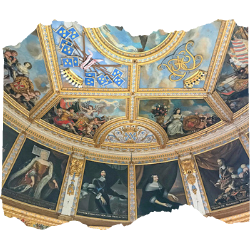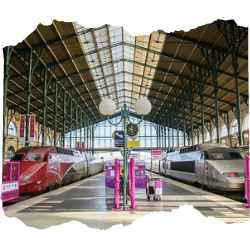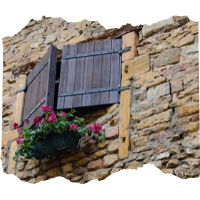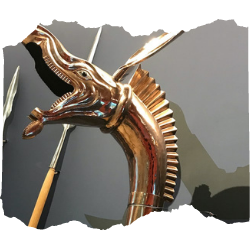Unsure about your French table manners? Click Here to download > > How to avoid these 10 food etiquette mistakes !
- Home ›
- Destinations ›
- France Less Visited ›
- Dijon
Visiting Dijon France? Let the dijon owl trail guide you
Updated 04 August 2023 by Leyla Alyanak — Parisian by birth, Lyonnaise by adoption, historian by passion
Walking the Dijon Owl Trail is a fun way to discover the city – I discovered places that would not otherwise have been on my list!
You won't find any wicked witches or end up in Kansas, I promise.
But following the Dijon Owl Trail is the best way to find all the things to do in Dijon and to get to know the city.
I admit I have a playful side and during my most recent visit to Dijon, I decided to try the path myself to see what all the fuss was about.
Following an owl to get around might sound a bit peculiar, but think of it as a self-guided walking around Dijon tour. Instead of a guide, you follow little owl plaques cemented into the sidewalk.
It's also quite flexible – you can spend as little or as long as you want along the trail. It's free, and you can go at your own pace.
COMING TO FRANCE? THESE RESOURCES CAN HELP!
🏨 Accommodation - I rent hotels quickly and easily through booking.com
🚘 Car rentals - I use Discovercars, Europe's best car rental website
🚊 Train tickets - I book my train and bus tickets on Omio or Trainline
🚌 Day tours - I take the best day tours with Viator and GetYourGuide
Of course you don't have to follow the trail – Dijon France is one of the most beautiful cities in the country and you can certainly visit it by walking around on your own.
The Dijon Owl's Trail just makes it easier... and a lot more fun!
NOTE: Pages on this site may contain affiliate links, which bring in a small commission at no cost to you.
What's all this about an owl in Dijon?
Owl trail, you say? Or, as it's known in French, the Parcours de la Chouette.
The owl is the symbol of Dijon, and the Dijon Owl Trail is the city's way of combining symbolism with practicality: just follow the (1600!) little owls set in the sidewalks of the Old Town and you'll eventually be guided past 22 of the main sights on your Old Dijon visit.
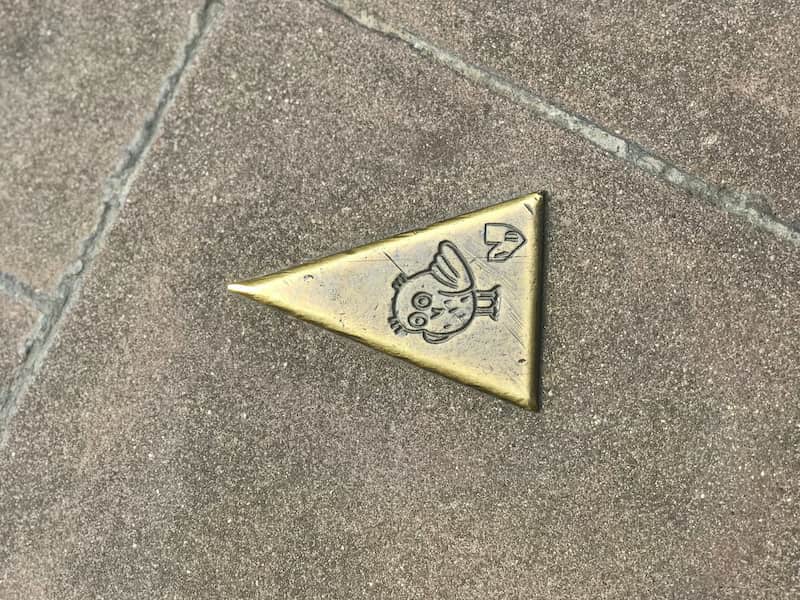 Owl trail Dijon marker
Owl trail Dijon markerOh, and one more thing... There is an owl sculpture nearby and you're supposed to pet it with your left hand because it has magical powers, but more on that in a moment.
Despite the owl's popularity, no one seems to know how this symbolism came to be. That it is so closely identified with Dijon is a mystery many have tried to pierce. Investigations have been launched, historical research undertaken, books written, but the owl's origins remains elusive.
Still, everyone has an interpretation, and, who knows, one of them may correct.
How the Dijon owl emerged from obscurity
A simple explanation would be that the owl, in Antiquity, was synonymous with wisdom, although the presence of such a pagan symbol on a Catholic church is questionable.
Or, the little owl might be a protection totem, designed to warn citizens of impending fire – many who could not afford stone houses did live in highly flammable wooden buildings, after all.
The owl could simply be the signature of an artist (one did exist with a similarly sounding name, Chouet...) or of the architect who designed Notre-Dame, against whose wall the owl sits. This theory, however, has been debunked by those who point out that the Rue de la Chouette, or Owl Street, is actually older than the church, which would mean the owl came before the church.
According to another legend dating back to the Middle Ages, an architect found a wounded owl on his path. After nursing it back to health, the owl helped the architect reconnoiter the church façade, to which some gargoyles were to be added. As the owl grew old and died, the architect sculpted this small facsimile in its honour.
KEEN TO VISIT BURGUNDY? USE DIJON FRANCE AS YOUR BASE
➽ Small-Group Full-Day Tour of Côte de Nuits, Côte de Beaune Vineyards and Beaune Historical District
➽ E-Bike Burgundy Champs Elysées Tour
How the owl became a symbol of good fortune
Not only can we not pinpoint the owl's origins, but we are equally in the dark when it comes to the tradition of touching it (with your left hand, while placing your right hand on your heart) and making a wish.
Rumour has it that in the late 17th century, a ghost appeared in the church and even a priest saw it, creating quite a stir. While church officials did what churches do to get rid of evil spirits, the good people of Dijon, just to be on the safe side, developed an additional tradition to chase away those evil spirits: they stroked the owl when they walked by it.
Wherever the truth may lie, this little owl carries Dijon's banner high, especially since the city almost lost it. In 2001, the owl was vandalized, nearly destroyed, and the city was in shock. Thankfully, a mould of the statuette existed and it was restored, although you can still see the damage.
At other times, it has been splashed with paint but again, the Dijonnais wouldn't stand for it, and it was quickly cleaned.
They may not know where it comes from, but the owl of Dijon occupies an increasingly large place in their heart and is the defacto symbol of the city.
Dijon France owl trail map
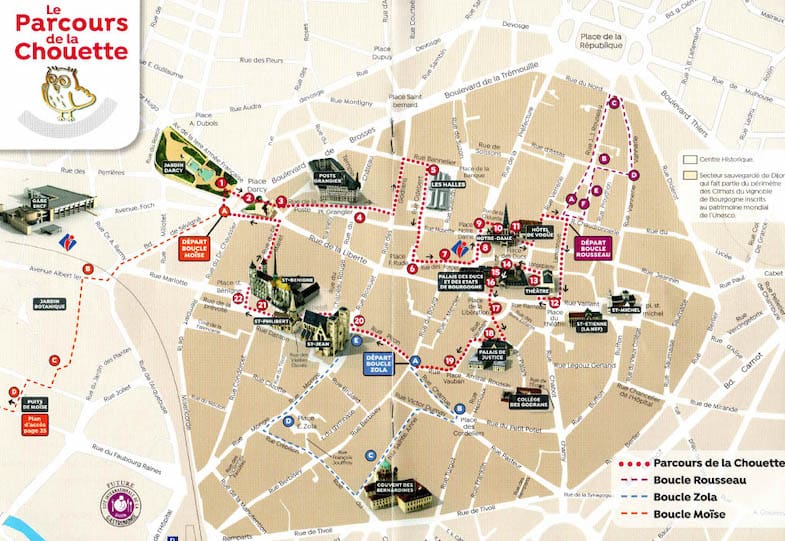 You can get a better quality map by buying the brochure at the Tourist Office - mine is just a reproduction of theirs ©DestinationDijon
You can get a better quality map by buying the brochure at the Tourist Office - mine is just a reproduction of theirs ©DestinationDijonAs you can see, there is a main route, with numbers from 1-22. You also have an additional three routes called Rousseau, Zola and Moïse. They're contiguous so it's easy to do all of them in one go.
Following the owl's main trail
One of the top things to do in Dijon is to walk the trail, but I'm not going to walk you through every single stop (although I will mention them). Otherwise, there won't be anything left for you to discover!
Instead, I'll point you towards some of those that struck me particularly, or whose backstories are offbeat or in some way unique.
For detailed instructions on the Owl's Trail Dijon, you can:
- get the Dijon owl trail app (available for Android but ask at the Dijon tourist office about an iPhone version)
- look at the map above or find a similar one online
- buy the Tourist Office booklet
Now, most people start at Jardin Darcy. It's convenient, the tram stops here, and it happens to be #1 on the map. However, the trail is circular, so you can join at any point and simply follow the pointers.
Be aware that the construction of new sidewalks may have covered up a few of the owl signs. This is now being fixed and all signs should shortly be back where they belong. If a few are missing, you'll quickly pick up the trail again if you glance at your Dijon sightseeing map.
1. Darcy Gardens
We know this is where the Owl's Trail starts, and it is a welcome pearl of greenery in which to cool off on hot summer days.
But who was Darcy?
Henry Philibert Gaspard Darcy was a hydraulic engineer, a native of Dijon, who solved the city's freshwater problem and gained worldwide fame by developing an equation related to the flow of fluids.
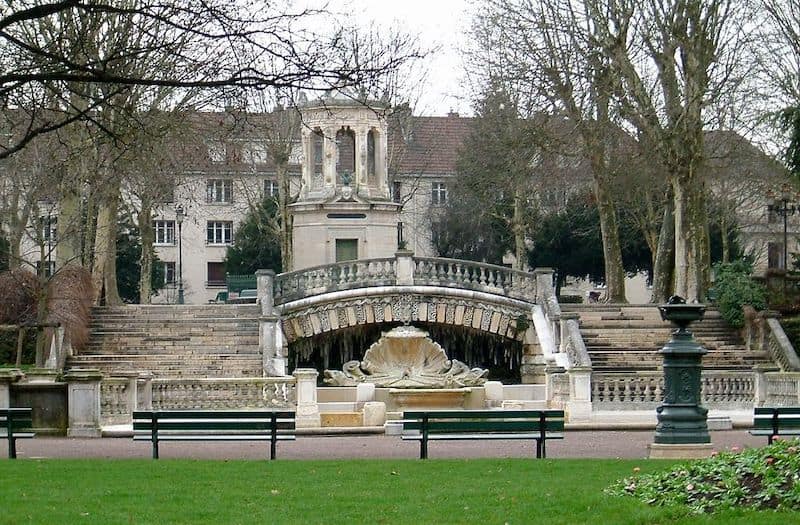 Darcy Park in Dijon by Christophe.Finot, CC BY-SA 2.5, via Wikimedia Commons
Darcy Park in Dijon by Christophe.Finot, CC BY-SA 2.5, via Wikimedia Commons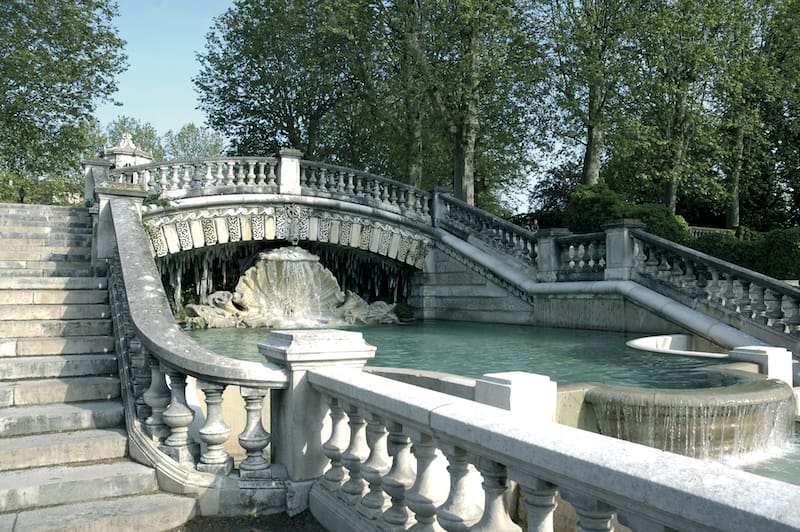 Another angle, another day at Darcy Gardens ©Office de Tourisme de Dijon - Atelier Demoulin
Another angle, another day at Darcy Gardens ©Office de Tourisme de Dijon - Atelier DemoulinAnd while the garden looks welcoming and filled with graceful fountains, what you may not know is that Darcy built the city's water supply right under the park in 1840. You can visit the reservoir once a year, when maintenance takes place and the water is drained (in normal times you'd would be under five meters of water).
At a time when Europe was plagued by illnesses caused by unclean water, Dijon's sanitation system made it the world's second best-supplied city in drinking water, after Rome.
2. Facade of the Grand Hôtel de la Cloche
With your back to Darcy Garden, you can't miss the Hôtel de la Cloche, the Hotel of the Bells.
Dijon has had a Hôtel de la Cloche since the 15th century, but the earlier one was closer to the center. The hotel moved to its present site once Darcy Square was built in the late 1880s.
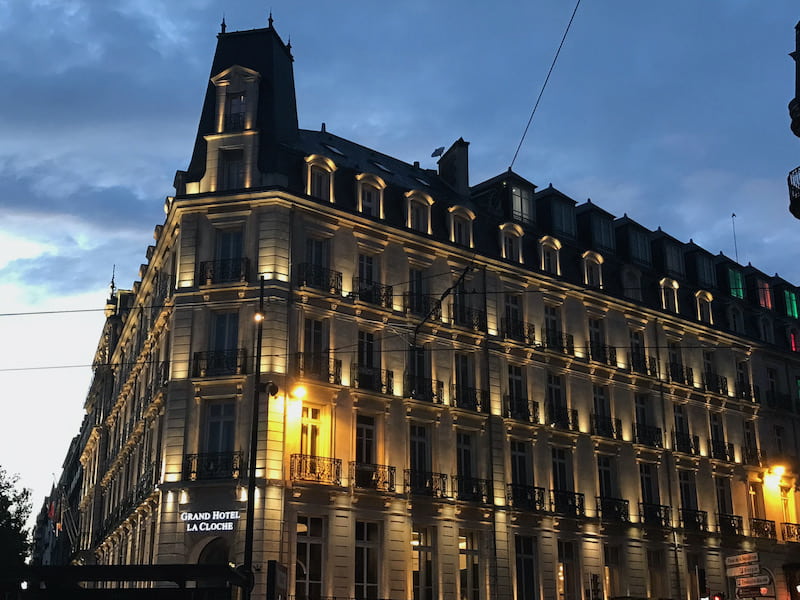 Grand Hotel de la Cloche, Dijon. "Cloche" means bell, and Dijon has long been known as the city of 100 bell towers...
Grand Hotel de la Cloche, Dijon. "Cloche" means bell, and Dijon has long been known as the city of 100 bell towers...Like many spectacular buildings, this one came close to being razed in the 1970s, in that crazy wave of destruction and so-called modernization that afflicted so many cities, not only in France but worldwide. Furniture was auctioned off, cutlery sold, and the bulldozers marched in – but the people rallied, the destruction became a national cause célèbre, and the engines were stopped in time to save the façade.
It was declared a national monument, pretty much guaranteeing it would survive (politicians have, on occasion, been able to override this status and destroy buildings protected by law... but it doesn't happen often).
It is now the city's only five-star hotel and has hosted celebrities of all eras – Napoleon III, Grace of Monaco, Joan Baez, Maurice Chevalier, MC Solaar...
And the windows are all decorated with bells which, after the owls, are probably Dijon's next most popular symbol.
3. Porte Guillaume
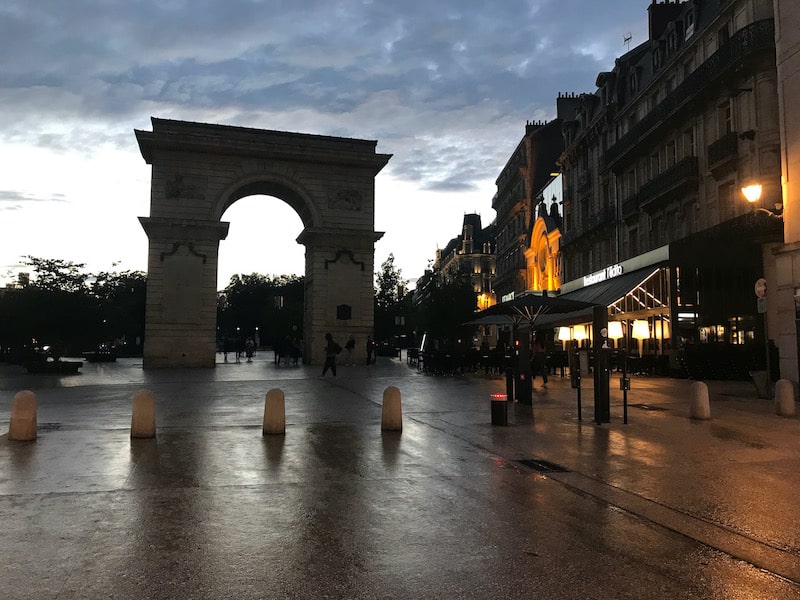
Still within easy sight of the Jardin Darcy, this stand-alone arch, the Porte Guillaume, bears a slight resemblance to the Arc de Triomphe in Paris, don't you think?
During the Middle Ages, a gateway was built here to protect the city, with a tower on each side and a drawbridge. The gate was part of the city's ramparts. These eventually stopped being essential and during the 18th century, it was decided to raze the old gate and build this triumphal arch instead.
Its mission: to give visitors a sense of Dijon's grandeur and to honour the Prince of Condé, who governed Burgundy at the time. The archway was named after him, until the next revolution, when it was rebaptized Gate of Freedom. It was finally renamed after Guillaume de Volpiano, abbot of Saint-Bénigne.
It may stand alone today, but if you stretch your imagination, you might be able to visualize an older, less ornate entryway, bordered by high walls destined to keep out invaders.
4. Poste Place Grangier
If you're an Art Nouveau lover, you'll want to admire the top of this corner building...
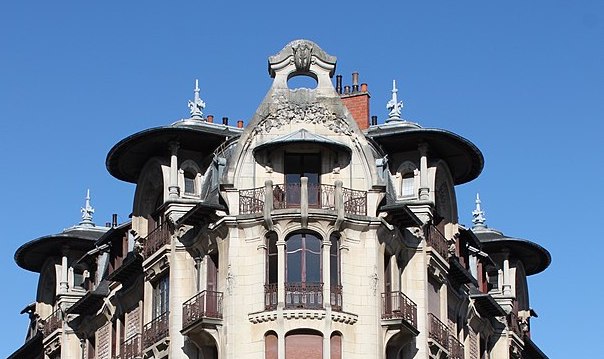 You'll be looking at this from a distance and an angle, so if you can get into one of the opposite buildings or if you have a telephoto, you'll be able to see more of the intricate details. Photo by Christophe.Finot, CC BY-SA 3.0, via Wikimedia Commons
You'll be looking at this from a distance and an angle, so if you can get into one of the opposite buildings or if you have a telephoto, you'll be able to see more of the intricate details. Photo by Christophe.Finot, CC BY-SA 3.0, via Wikimedia Commons5. Les Halles
Like the Grand Hôtel de la Cloche, Les Halles barely escaped the bulldozer. In 1975, it was slated for destruction and would have been dismantled – and replaced with a parking lot! – had it not been added to the national list of historical monuments. Greed, for once, did not win out.
The iron structure is often attributed to Gustave Eiffel (of Eiffel Tower fame), possibly because he was born in Dijon and is identified with the city. Much as one might wish to claim the indoor market as his, credit for it goes instead to several city architects and engineers.
Before Les Halles? The site was occupied by an old Jacobean convent.
If you can time your arrival here for lunch, please do. The market is open Tuesday, Thursday, Friday and Saturday, and you'll find every possible product under the sun in here.
Grab a French baguette, some cheese and charcuterie, a bit of wine... and have your lunch on a bench or in the Jardin Darcy. Failing that, try one of the nearby restaurants around Les Halles but go early, they fill up quickly.
Sundays in summer, Les Halles hosts brunches in the alleys of the market, not to be missed!
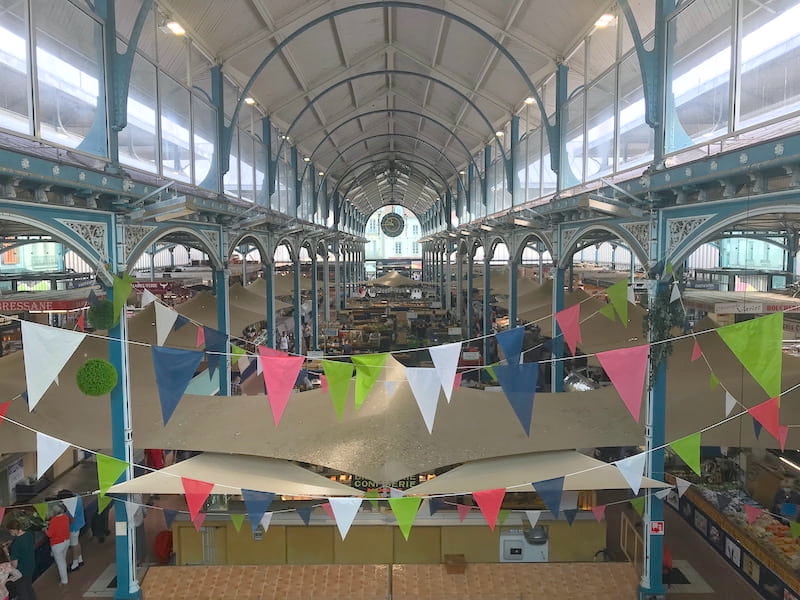 Halles de Dijon
Halles de Dijon6. Place François Rude
This square's namesake was a Dijon-born sculptor, responsible for one of the major carvings on the Arc de Triomphe in Paris. It's a relatively recent space, cleared just over a century ago. Just remember him and look for his panel on the Parisian Arch: it's called La Marseillaise.
7. Rue des Forges
Wander down this street to admire some of the sumptuous residences built from the Middle Ages to the Renaissance.
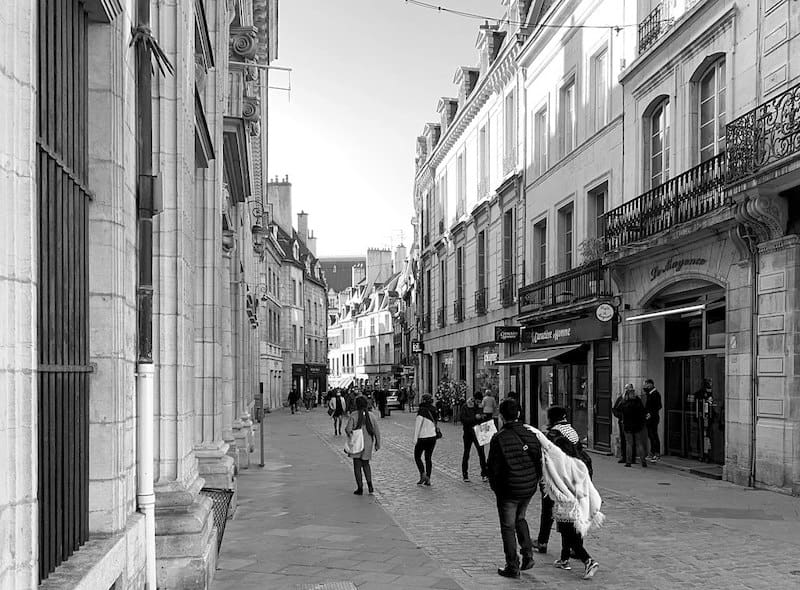 Rue des Forges (Photo
Benoît Prieur, CC0, via Wikimedia Commons)
Rue des Forges (Photo
Benoît Prieur, CC0, via Wikimedia Commons)8. Notre-Dame
What on earth is a jacquemart??
I had to look it up: it's an automatic bell-ringer (made of metal or wood) which hits the bell every hour with a hammer. One of the most famous sits on top of the Church of Notre Dame, and you can see it in the photograph below.
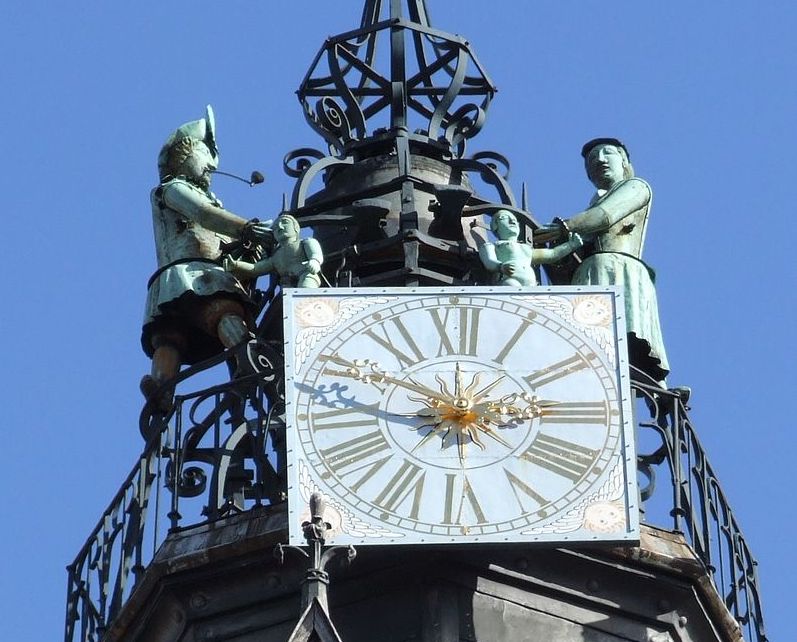 The famous jacquemart of Notre-Dame, by Christophe.Finot, CC BY-SA 2.5, via Wikimedia Commons
The famous jacquemart of Notre-Dame, by Christophe.Finot, CC BY-SA 2.5, via Wikimedia CommonsThe two adults are called Jacquemart and Jacqueline, and they hammer the big bell every hour.
The two smaller ones, Jacquelinet and Jacquelinette, do it on the quarter hour, on smaller bells.
What is so unusual about these is the date: Jacquemart (initially he was alone) came to Dijon in... 1383. And yes, automation is not as recent as we think.
Jacquemart, along with the clock and big bell, was brought from Kortrijk in Belgium (known as Courtrai in French) by Philip the Bold, Duke of Burgundy and offered as a gift to Dijon for having provided him with 1000 armed men to fight in Flanders. (The bell broke on the way and had to be recast...)
Jacqueline was added in 1651 and would strike alternate hours (wouldn't want to tire out Old Jacquemart). In 1714, Jacquelinet was added for the quarter-hours and finally, in 1884, Jacquelinette rounded out the family.
In France, one in five families is what is called "nombreuse", or numerous, meaning it has four children or more. Who knows, perhaps we'll be seeing the addition of another little brother or sister...
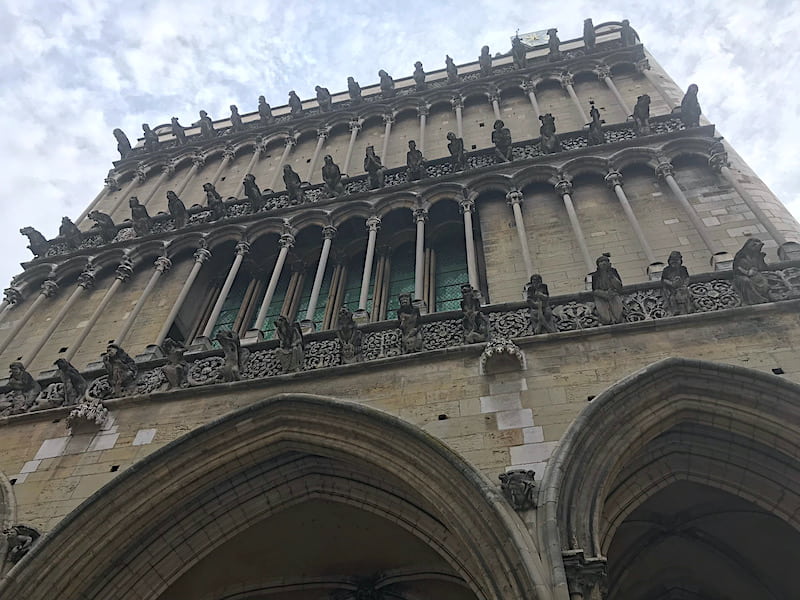 This church is better known for its western façade (shown here) and for its gargoyles (lined up all along the façade) ©OffbeatFrance
This church is better known for its western façade (shown here) and for its gargoyles (lined up all along the façade) ©OffbeatFranceTry to step back from the church – the angle is not ideal for a photograph, unless you have a proper DSLR camera with a good lens. Using an iPhone will give you the same result as it did me, above.
9. The Owl
And here it is, what you've been waiting for: the Owl!
Touching the owl with your left hand is supposed to bring you luck, but be careful.
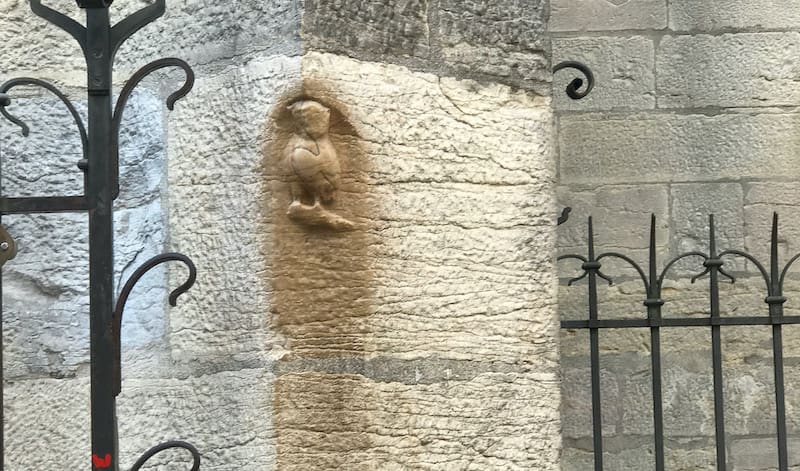 The Dijon owl was vandalized a while ago and had to be repaired - you can still see the line that glues the parts together ©OffbeatFrance
The Dijon owl was vandalized a while ago and had to be repaired - you can still see the line that glues the parts together ©OffbeatFranceTo the left of the owl, on another wall, is a tiny dragon, (some say it's a salamander), so small it's easy to miss. If you walk past the owl and make a wish and then walk past the dragon, that evil little dragon will steal your wish. So if you want it to come true, walk past the dragon first, and then the owl, and all will be fine.
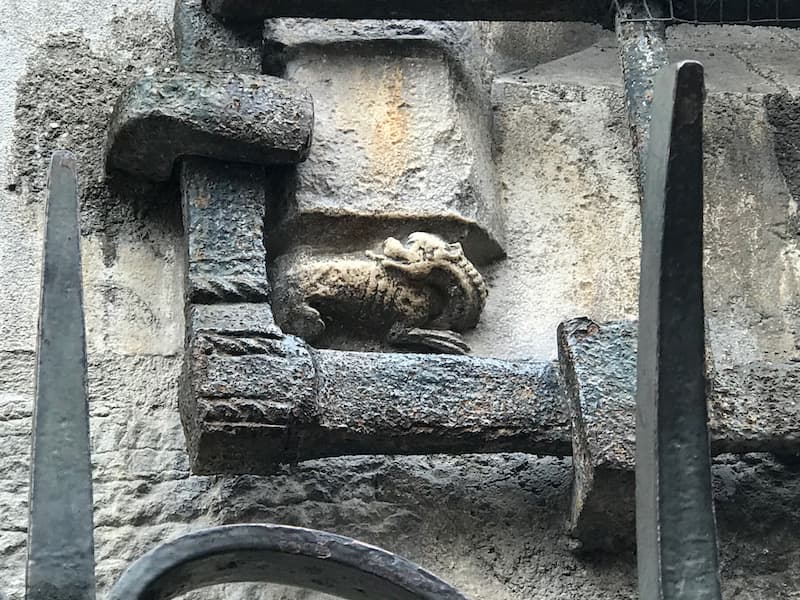 Earlier in this story I showed you the owl. Now here is a close-up of the little dragon, lest you should miss it (some people say it is a salamander...) ©OffbeatFrance
Earlier in this story I showed you the owl. Now here is a close-up of the little dragon, lest you should miss it (some people say it is a salamander...) ©OffbeatFrance10. Maison Millière
Known as the Doyenne of Dijon, this is one of the city's oldest half-timbered houses and can be dated back to 1483. It became the property of a certain Guillaume Millière and his wife, Guillemette, both drapers from nearby Beaune.
At the time, an even older house stood on these premises but being undoubtedly modern, they razed it to build bigger and better – and applied for a tax rebate, which may not have been granted. Had Millière waited a few years, his great-grandson would have been Mayor of Dijon and those taxes might well have been erased from the chalkboard.
As houses do, this one passed through other hands but somehow survived centuries, despite laws forbidding the renovation of wooden houses (fire hazards, right?).
At some point it did heave a bit and was closed down, only to reopen as a hardware store in 1927. More restorations took place in the late 1990s and turned it into the best possible use: a restaurant (and traditional on-site boutique).
Up on the roof sits a black bronze cat, which of course has a superstition attached to it: once you've touched the Dijon owl, don't look at the cat, because, like the dragon/salamander, it could upend your wish.
Next to the cat is a ceramic owl, whose job it is to make sure your wish speeds skyward. So make it a really good wish, because it seems a lot of acrobatics are involved!
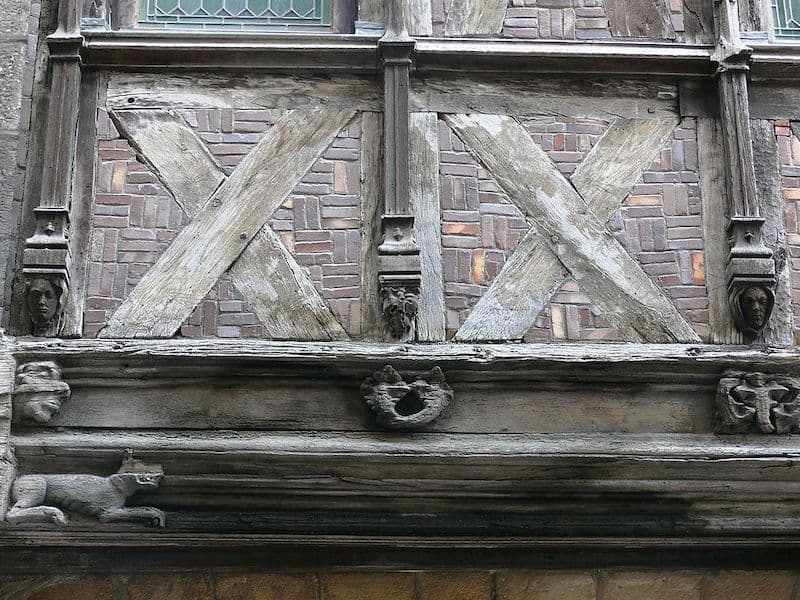 A close-up of the brick and wood work on the Maison Millière in Dijon, photo MOSSOT, CC BY 3.0, via Wikimedia Commons
A close-up of the brick and wood work on the Maison Millière in Dijon, photo MOSSOT, CC BY 3.0, via Wikimedia Commons11. Hotel Vogüé
One of the best things to do in Dijon is explore its architecture, which ranges across centuries. One of the more unusual styles is Classical Burgundian, which you'll see in a number of urban manor houses, known as hôtels particuliers.
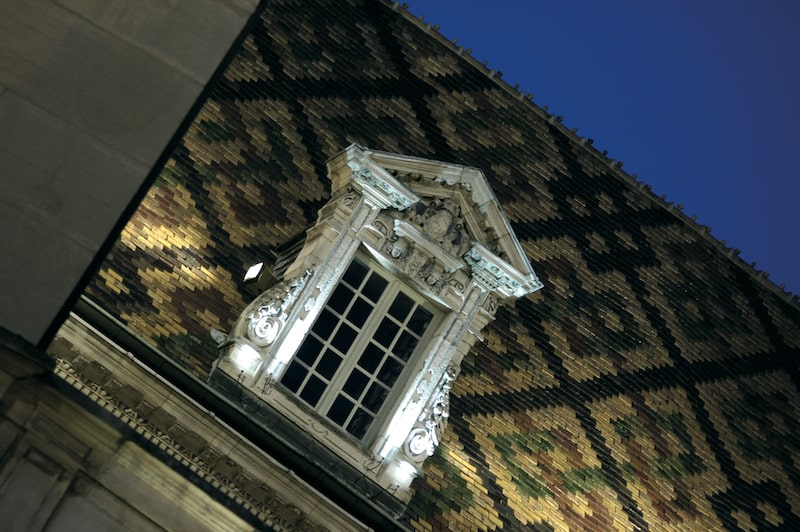 It's a night shot but it shows the distinguishing glazed tiles of the roof. A spectacular building all round. Photo © Office de Tourisme de Dijon - Atelier Demoulin
It's a night shot but it shows the distinguishing glazed tiles of the roof. A spectacular building all round. Photo © Office de Tourisme de Dijon - Atelier DemoulinThese are basically townhouses for wealthy Dijonnais, and the Hotel Vogüé is one of the best examples of this type of architecture, with the Burgundian glazed roof tiles and some definite Renaissance touches.
12. Place du Théâtre | 13. Place de la Sainte Chapelle
I'll let you discover these on your own - wonderful historical buildings that find new life as cutting-edge cultural venues.
14. Square des Ducs
This is a pleasant spot of greenery, right behind the dukes' palace (see below) and an alternative to Darcy Park for that picnic with all those goodies you picked up at Les Halles. This is the square through which you enter the Tower of Philippe Le Bon, about which you'll hear shortly.
15. Palace of the Dukes of Burgundy
Possibly topping the list of things to do in Dijon is a visit to the Palace of the Dukes of Burgundy.
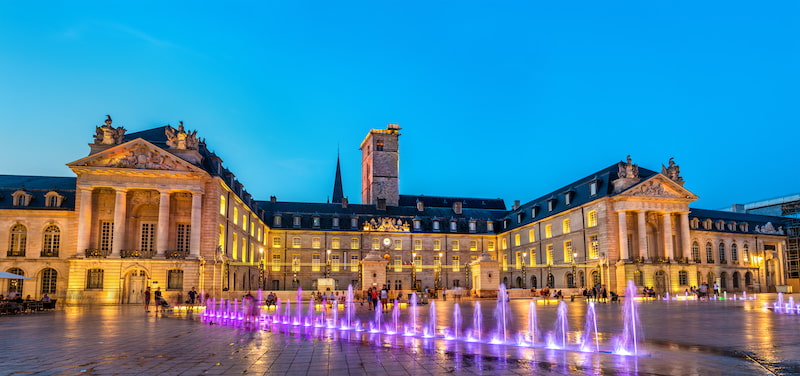
Now part City Hall and part Fine Arts Museum (Musée des Beaux Arts), this building had been, in turn, a ducal residence, a seat of government, and a home for the Senate.
And this isn't even the original; as is the case with many castles in France, this one burned down, and was then rebuilt. Twice.
The Fine Arts Museum is known as one of the best in France, and in addition to all the art, you'll be spellbound by the tombs of two (of the four) Dukes of Burgundy.
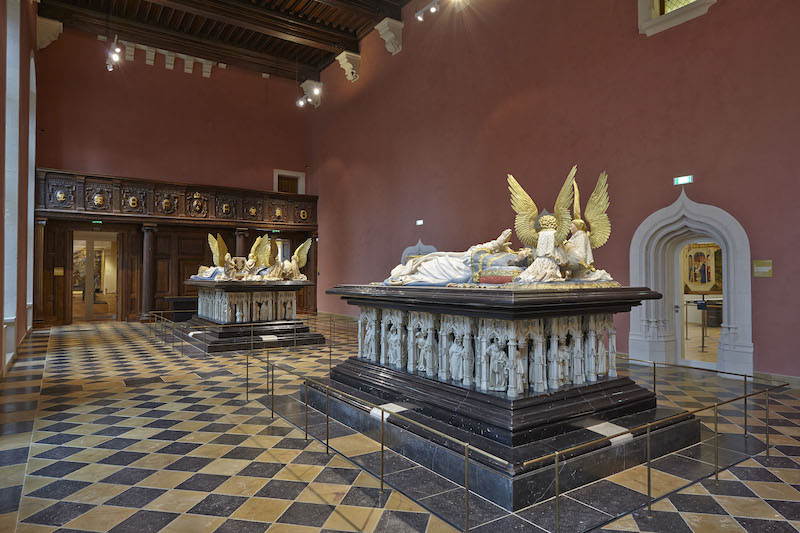 The spectacular tombs held in the Museum of Fine Arts of Dijon ©Musée des beaux-arts Dijon, François Jay
The spectacular tombs held in the Museum of Fine Arts of Dijon ©Musée des beaux-arts Dijon, François JayAS ALWAYS, A BIT OF HISTORY
Burgundy, as you may know by now, was not always part of France. In fact, it was allied with England several times, and once governed Flanders, in what is now Belgium.
The Dukes of Burgundy were members of the French royal family (not friendly members – they wanted to be kings themselves). Based on the wealth of Flanders, which in the 15th century was a global business and financial crossroads, Burgundy prospered. This palace was part of that prosperity.
16. Tour Philippe le Bon
I hesitated long and hard before climbing the tower: 316 steps is nothing to sneer at, but it was worth every heart-pumping step. Here's the view.
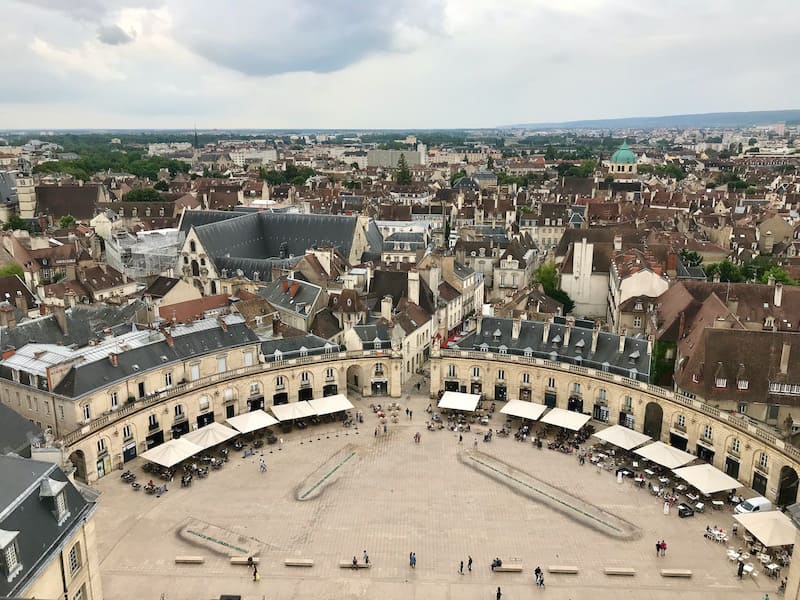 This gives you an idea of the view, with the Place de la Libération below
This gives you an idea of the view, with the Place de la Libération belowIt is absolutely worth your while, but make sure you reserve, because you can't go up without a guide.
17. Place de la Libération
The square once boasted a statue of Louis XIV but, like many kingly statues, it was melted into cannonballs during the French Revolution. Today the square is lined with cafés and restaurants, with a central fountain, dancing with lights after sunset, focuses the eye as we gaze at the Palace of the Dukes of Burgundy straight ahead.
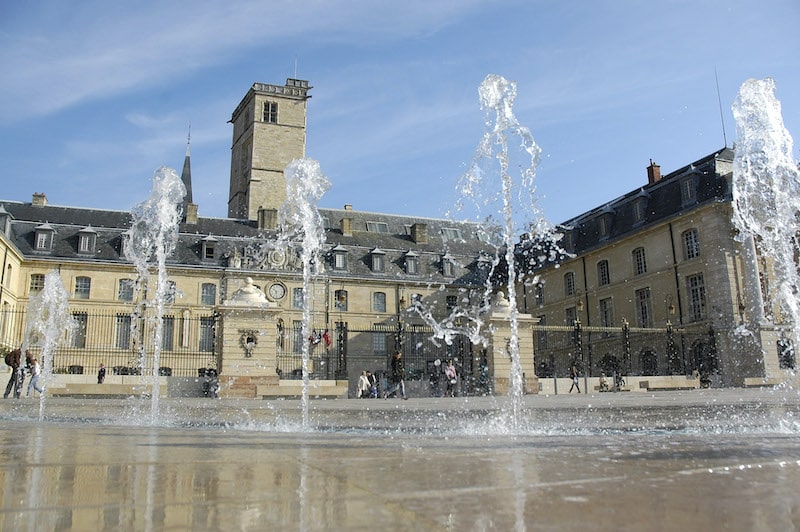 The Place de la Libération and its cafés is at your back, and ahead you can see (in addition to the Palace of the Dukes of Burgundy) the Tour de Philippe le Bon, it of the 300-plus steps
The Place de la Libération and its cafés is at your back, and ahead you can see (in addition to the Palace of the Dukes of Burgundy) the Tour de Philippe le Bon, it of the 300-plus steps18. Palais de Justice
By all accounts, this is a stunning building – except that when I walked by, it was covered in scaffolding and being renovated. It should end up looking even better...
19. Hôtels Particuliers
I've mentioned these hotels particuliers earlier and can count about 75 – there are probably many more. Several are along the Owl Trail, like the Hôtel Vogüé, but you can spot many others thanks to the plaques the city uses to identify them.
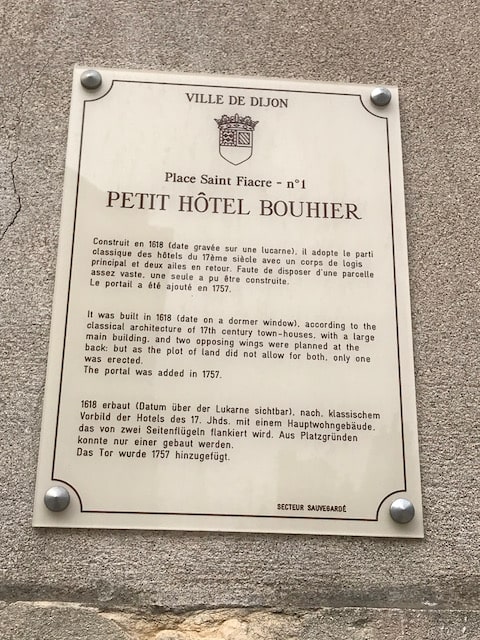
20. Saint-Jean et la Place Bossuet, 21. Saint-Philibert and 22. Saint-Bénigne
These three church buildings are each unique: Saint-Jean has been converted into a theater, Saint-Philibert dates back to the 12th century (during the revolution, it became a stable and then a salt warehouse) and Saint-Bénigne is typical of the local gothic style and has a magnificent glazed tile roof.
Remember I mentioned Dijon was called the city of 100 bell towers? Sainte-Bénigne has the tallest of them all.
Rousseau, Zola and Moïse Trails
Yes, there isn't just ONE owl's trail, there are FOUR!
Each of these smaller "offshoot" trails starts from a different point along the Owl's Trail and are all as clearly marked as the main trail. Each is worth a detour. For example, the Zola Trail takes you to the Couvent des Bernardines, a former convent which now houses the delightful Museum of Burgundian Life.
The beauty of Dijon is that it is easily visited on foot. And if you get tired, you can always hop on the free electric City Shuttle, which comes by every ten minutes and stops at most of the major Dijon sights.
Once you've finished with Dijon, explore the countryside: here's a fun day trip from Dijon – it's a lot to pack into a day but you'll have a strong sense of Burgundy and of the Côte d'Or département once you're done.
Essential France travel resources
BOOK YOUR ACCOMMODATIONS
I use booking.com: for their huge inventory and for their easy cancellation policies
FLIGHT DELAYED OR CANCELED?
AirHelp can get you compensation (it works, I've used it)
DO YOU NEED AN E-SIM CARD FOR FRANCE?
Here's the one I use when I travel anywhere
PROTECT YOUR BELONGINGS
Keep pickpockets away with an anti-theft purse or an infinity scarf - and your identity with a VPN (I'm using Nord VPN)
TRAVEL INSURANCE
Travelers recommend Visitors' Coverage or SafetyWing. for health away from home
GETTING FROM A TO B
I use Discovercars to rent cars and either Omio or RailEurope for train tickets
TO READ ABOUT FRANCE
Here's my long list of books about France
AND DON'T FORGET...
To bring a guidebook for France!
FAQ Dijon Owl Trail
Where does the owl trail start in Dijon?
Where does the owl trail start in Dijon?
You can start anywhere along the main trail, which is circular. The first "official" stop is Darcy Gardens.
Is Dijon worth visiting?
Is Dijon worth visiting?
The city of Dijon is full of attractions. The city was the capital of Burgundy and therefore full of history. It is also right in the heart of Burgundy, in case you plan to go wine tasting.
How many days in Dijon would be enough to visit the city?
How many days in Dijon would be enough to visit the city?
You can visit the city and its major attractions in two days but if you'd like to head to the Burgundy vineyards, you'll have to add on at least one extra day.
How do you say owl in French?
How do you say owl in French?
Hibou, pronounced he-BOO.
What is the story of the owl of Dijon?
What is the story of the owl of Dijon?
There are many stories of origin about the owl, but no consensus. It might refer to the wisdom of the owl in Antiquity, it could be a protection totem to warn about fires, it might be a simple work of art, or it might refer to a wounded owl found by the architect of Notre-Dame church, on which the owl is carved.
What is the difference between Dijon mustard and other mustards?
What is the difference between Dijon mustard and other mustards?
The difference lies in the mustard seeds used to make the mustard.
Dijon mustard uses black seeds, which makes it spicier. Yellow mustard uses yellow and white mustard seeds.
What are some good day trips from Dijon?
What are some good day trips from Dijon?
It's easy to organize a Dijon day trip because there are so many things to see nearby.
You can head down the Burgundy Wine Route all the way to Beaune, of course. You can visit the Auxois region of Burgundy, the village of Flavigny-sur-Ozerain (where the film Chocolat was shot), or learn about French history by visiting the site of Rome's victory over Gaul.
Final thoughts on the Dijon Owl Trail
In many cities, a guided walking tour is the best way to visit. But in Dijon, I beg to differ. The Owl's Trail is well organized, thorough, and a lot more fun to follow.
While it takes you through all the major Dijon tourist attractions, in my opinion the trail is a major attraction itself.
I was fortunate to partner with Destination Dijon, the city's tourist office. They showed me the way but opinions are mine (I'm highly opinionated and plan to stay that way).
You might also like these stories!
Pin these and save for later!
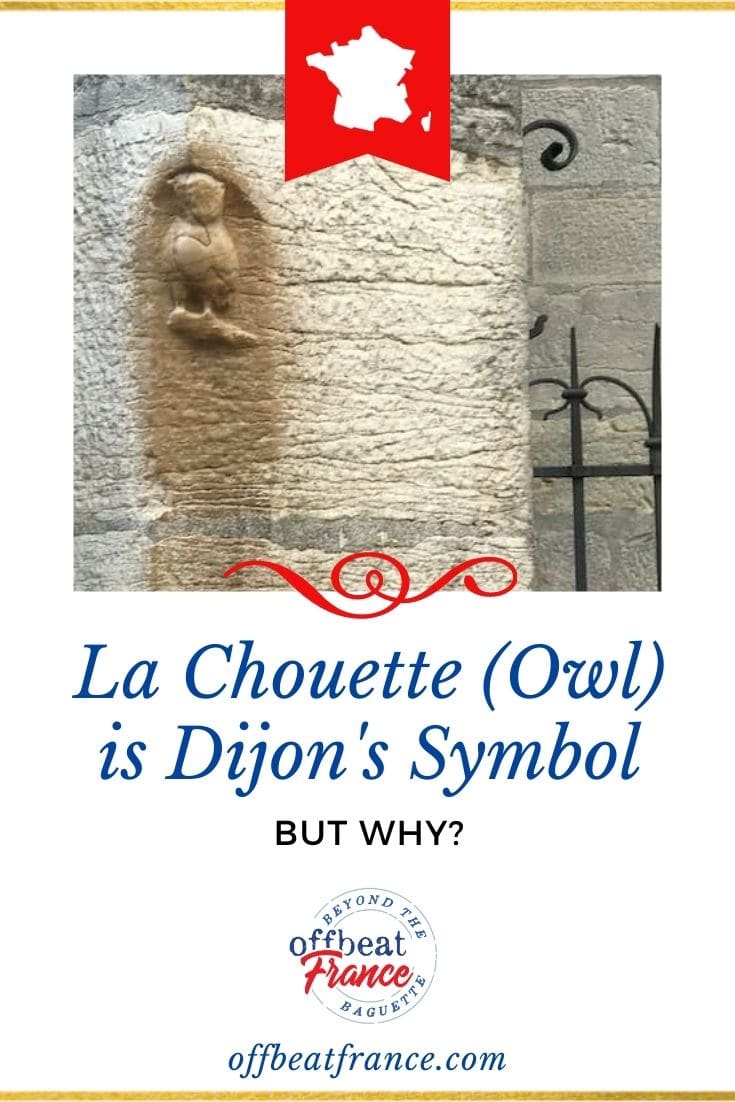
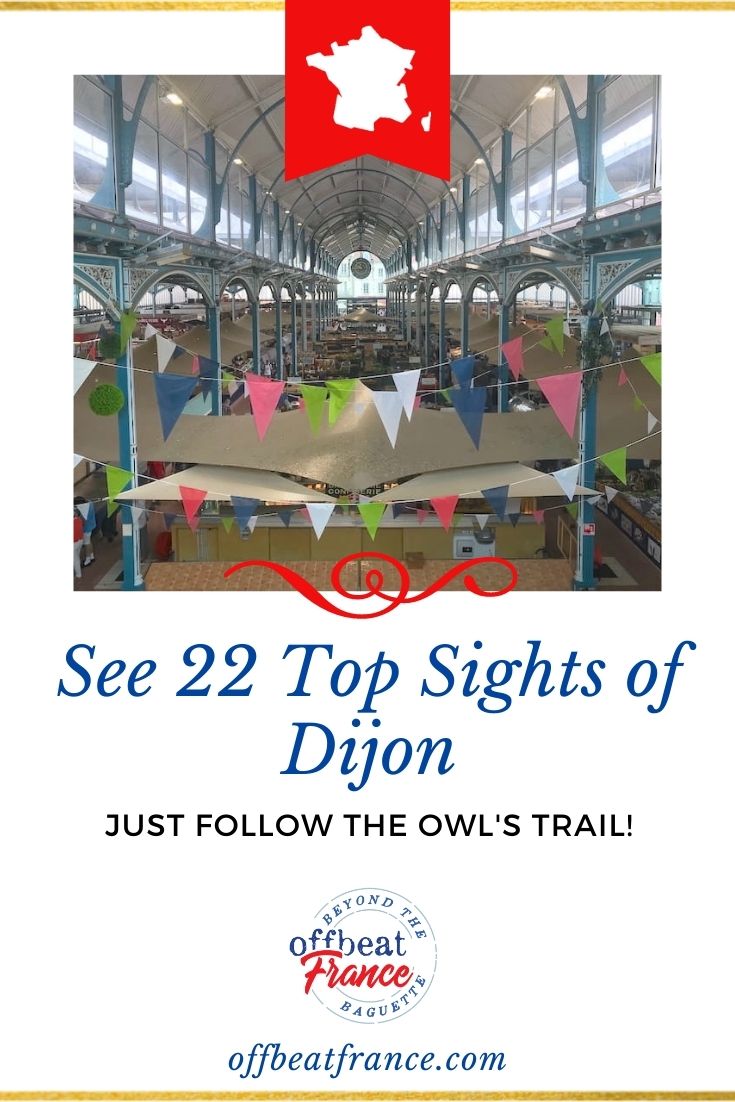
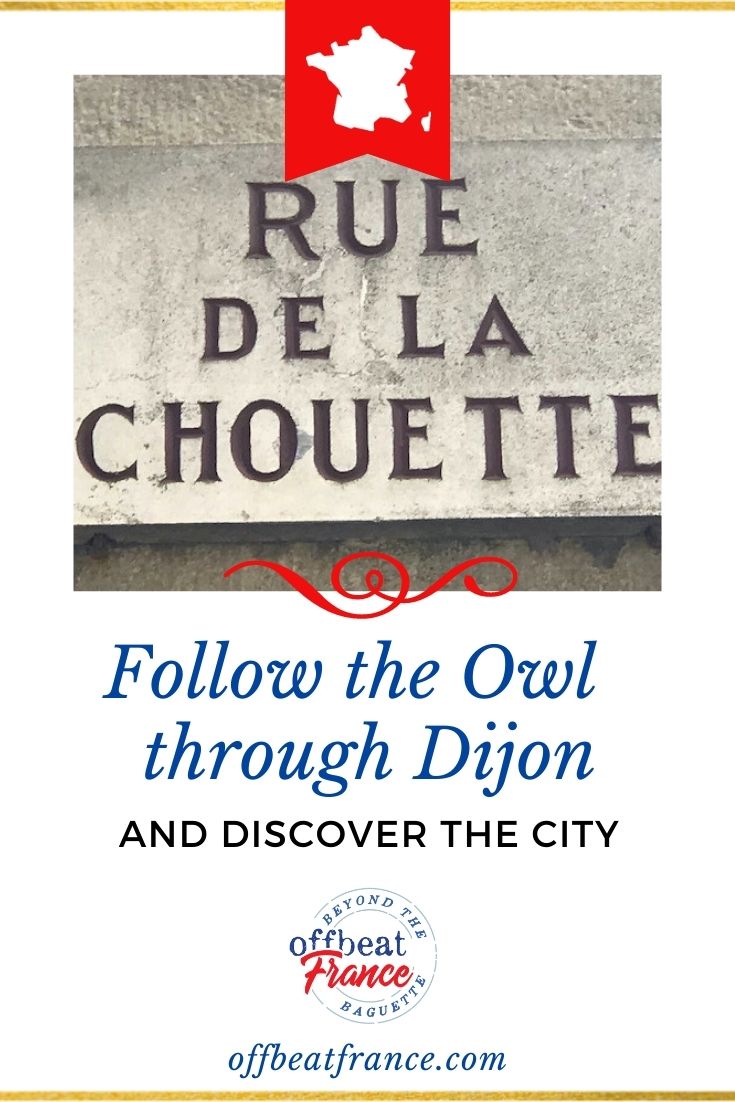
Did you enjoy this article? I'd love if you shared it!
